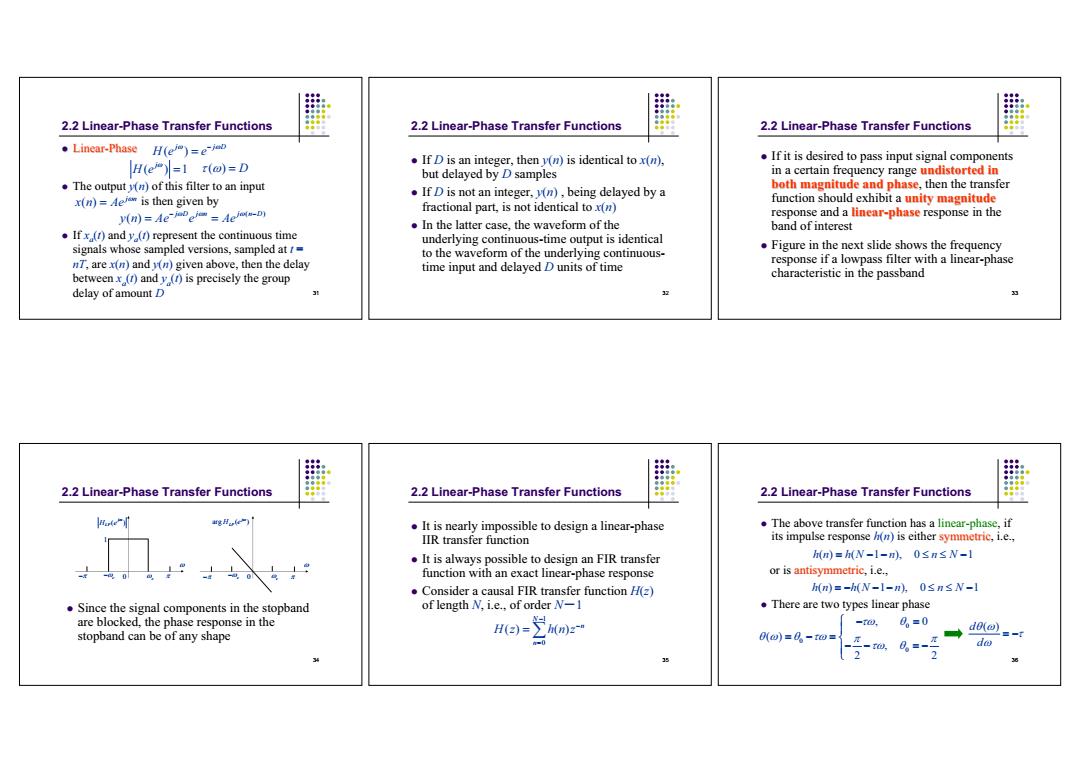正在加载图片...

2.2 Linear-Phase Transfer Functions 2.2 Linear-Phase Transfer Functions 2.2 Linear-Phase Transfer Functions .Linear-Phase H(ei)=e-joo If D is an integer,then y(n)is identical to x(n), If it is desired to pass input signal components H(ei)=1 r(@)=D but delayed by D samples in a certain frequency range undistorted in .The output y(n)of this filter to an input If D is not an integer,y(n),being delayed by a both magnitude and phase,then the transfer x(n)=Aeicm is then given by function should exhibit a unity magnitude fractional part,is not identical to x(n) y(n)=Ae-jobei=Aejo-D) response and a linear-phase response in the .In the latter case,the waveform of the band of interest .Ifx (r)and y (1)represent the continuous time underlying continuous-time output is identical signals whose sampled versions,sampled at t= to the waveform of the underlying continuous- Figure in the next slide shows the frequency nT.are d(n)and vn)given above,then the delay time input and delayed D units of time response if a lowpass filter with a linear-phase between x (r)and y (r)is precisely the group characteristic in the passband delay of amount D 2.2 Linear-Phase Transfer Functions 2.2 Linear-Phase Transfer Functions 2.2 Linear-Phase Transfer Functions oT It is nearly impossible to design a linear-phase The above transfer function has a linear-phase,if IIR transfer function its impulse response h(n)is either symmetric,i.e., It is always possible to design an FIR transfer n)=hN-1-a,0sn≤N-1 function with an exact linear-phase response or is antisymmetric,i.e., Consider a causal FIR transfer function (z) h(n)=-h(N-1-n),0snsN-1 Since the signal components in the stopband of length N,i.e.,of order N-1 There are two types linear phase are blocked,the phase response in the -r@, 0=0 stopband can be of any shape 0)=0-t@= →do@l.-r 2 -wA=- do 231 2.2 Linear-Phase Transfer Functions Linear-Phase The output y(n) of this filter to an input is then given by If xa(t) and ya(t) represent the continuous time signals whose sampled versions, sampled at t = nT, are x(n) and y(n) given above, then the delay between xa(t) and ya(t) is precisely the group delay of amount D ( ) j jD He e ( )1 j H e ( ) D ( ) j n x n Ae ( ) ( ) jD jn j nD y n Ae e Ae 32 2.2 Linear-Phase Transfer Functions If D is an integer, then y(n) is identical to x(n), but delayed by D samples If D is not an integer, y(n) , being delayed by a fractional part, is not identical to x(n) In the latter case, the waveform of the underlying continuous-time output is identical to the waveform of the underlying continuoustime input and delayed D units of time 33 2.2 Linear-Phase Transfer Functions If it is desired to pass input signal components in a certain frequency range undistorted in undistorted in both magnitude and phase both magnitude and phase, then the transfer function should exhibit a unity magnitude unity magnitude response and a linear-phase response in the band of interest Figure in the next slide shows the frequency response if a lowpass filter with a linear-phase characteristic in the passband 34 2.2 Linear-Phase Transfer Functions ( ) j H e LP c 0 c 1 arg ( ) j H e LP c 0 c Since the signal components in the stopband are blocked, the phase response in the stopband can be of any shape 35 2.2 Linear-Phase Transfer Functions It is nearly impossible to design a linear-phase IIR transfer function It is always possible to design an FIR transfer function with an exact linear-phase response Consider a causal FIR transfer function H(z) of length N, i.e., of order Nˉ1 1 0 () () N n n H z hnz 36 2.2 Linear-Phase Transfer Functions The above transfer function has a linear-phase, if its impulse response h(n) is either symmetric, i.e., or is antisymmetric, i.e., There are two types linear phase hn hN n n N ( ) ( 1 ), 0 1 hn hN n n N ( ) ( 1 ), 0 1 0 0 0 , 0 ( ) , 2 2
d ( ) d
������������������������������������������